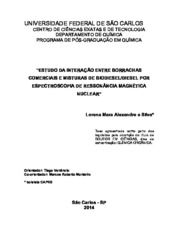| dc.contributor.author | Silva, Lorena Mara Alexandre e | |
| dc.date.accessioned | 2016-06-02T20:35:01Z | |
| dc.date.available | 2015-03-11 | |
| dc.date.available | 2016-06-02T20:35:01Z | |
| dc.date.issued | 2014-10-09 | |
| dc.identifier.citation | SILVA, Lorena Mara Alexandre e. Study of interaction between commercial rubber and mixtures of biodiesel/diesel through nuclear magnetic resonance spectroscopy. 2014. 134 f. Tese (Doutorado em Ciências Exatas e da Terra) - Universidade Federal de São Carlos, São Carlos, 2014. | por |
| dc.identifier.uri | https://repositorio.ufscar.br/handle/ufscar/6337 | |
| dc.description.abstract | Nowadays biodiesel has taken steps toward the consolidation as energetic matrices of many countries. Elastomers are one of the most important groups of materials used in engines and the compatibility of these materials with biodiesel is a growing concern. Thus, to correlate important information about compartmentalized phases of rubber/fuel system, low and high field NMR and emerging technologies such as hybrid NMR probe and imaging through mass spectrometry (DESI), were employed. This work permitted, for the first time, to understand the structural and chemical changes that diesel and mainly biodiesel induces in the structure of vulcanized rubber. For natural rubber (NR), the low-field NMR experiments have shown that the damage did not occur at the polymer crosslinking but biodiesel mostly affects the interaction between the filler and rubber. The high resolution NMR also allowed verifying the exudation of the filler and filler aggregates. The use of Comprehensive Multi-Phase NMR applied to NR, nitrilic rubber (NBR), styrene-butadiene rubber (SBR) and ethylene-propilene-diene rubber (EPDM), permitted to study the different phases coexisting in the complex fuel/rubber system as well as the interface between these phases. These data indicated that the carbon black aggregates are being exudate and thus, the demand for fillers with higher affinity with the elastomers seems to be one of the most important parameters in the search for materials more compatible with biodiesel. Thus, in molecular level it can be seen that the elastomer less affected by the presence of biodiesel was EPDM, followed by SBR, NR and NBR. Besides it was observed the inclusion of biodiesel molecules into the EPDM structure, in contrast to other data in literature. This finding can infer about the long-term degradation of the elastomeric structure. Furthermore, DESI demonstrated that biodiesel trapped at the EPDM is in the oxidized and unoxidized forms, and probably this oxidation has a greater effect on the structure of the rubber. | eng |
| dc.description.sponsorship | Financiadora de Estudos e Projetos | |
| dc.format | application/pdf | por |
| dc.language | por | por |
| dc.publisher | Universidade Federal de São Carlos | por |
| dc.rights | Acesso Aberto | por |
| dc.subject | Química orgânica | por |
| dc.subject | Biodiesel | por |
| dc.subject | Borracha | por |
| dc.subject | Ressonância magnética nuclear | por |
| dc.title | Estudo da interação entre borrachas comerciais e misturas de biodiesel/diesel por espectroscopia de ressonância magnética nuclear | por |
| dc.title.alternative | Study of interaction between commercial rubber and mixtures of biodiesel/diesel through nuclear magnetic resonance spectroscopy | eng |
| dc.type | Tese | por |
| dc.contributor.advisor1 | Venâncio, Tiago | |
| dc.contributor.advisor1Lattes | http://lattes.cnpq.br/4438399441102990 | por |
| dc.description.resumo | Hoje em dia o biodiesel tem se consolidado como uma matriz energética importante em muitos países. Os elastômeros integram uma classe importante de materiais, com aplicação em diversas áreas e principalmente, são vastamente utilizados em motores automobilísticos. Assim, a compatibilidade dos elastômeros com biodiesel é uma preocupação crescente. Para obter e correlacionar informações importantes das fases compartimentadas no sistema borracha/combustível, foram empregados a RMN em baixo, alto campo e tecnologias emergentes como a sonda híbrida de RMN compreensiva de multifases e obtenção de imagens por espectrometria de massas (DESI). Estas técnicas permitiram, pela primeira vez, entender as alterações estruturais e químicas que o biodiesel induz na estrutura de borrachas vulcanizadas. Para a borracha natural vulcanizada, os experimentos de baixo campo demonstraram que os danos não ocorrem nas ligações cruzadas do polímero e que o biodiesel provoca grandes modificações na interação entre o enchimento e a borracha. A RMN de alta resolução permitiu a comprovação da exsudação do material de enchimento e seus agregados. Com a RMN compreensiva aplicada às borrachas natural (NR), nitrílica (NBR), estireno-butadieno (SBR) e etileno proprileno dieno (EPDM), foi possível estudar as diferentes fases coexistentes no sistema complexo combustível/borracha, bem como a interface entre as fases. Estes dados indicaram que está ocorrendo a exsudação de agregado de negro de carbono e, deste modo, a procura de cargas com maior afinidade com elastômeros parece ser um dos parâmetros mais importantes na pesquisa por materiais compatíveis com o biodiesel. Assim, foi possível verificar que o elastômero que apresenta menor susceptibilidade ao biodiesel, em termos moleculares, foi a EPDM, seguido da SBR, VNR e, por fim a NBR. Além disso, apesar de trabalhos publicados afirmarem que o diesel tem maior efeito na EPDM, foi verificado a presença de moléculas de biodiesel incrustradas na estrutura do elastômero, o que pode causar a longos prazos, maior relaxação das cadeias elastoméricas. Ademais, o DESI demonstrou que o biodiesel incrustrado na EPDM está na forma oxidada e não oxidada e, provavelmente, esta oxidação tem maior efeito na estrutura da borracha. | por |
| dc.publisher.country | BR | por |
| dc.publisher.initials | UFSCar | por |
| dc.publisher.program | Programa de Pós-Graduação em Química - PPGQ | por |
| dc.subject.cnpq | CIENCIAS EXATAS E DA TERRA::QUIMICA | por |
| dc.contributor.authorlattes | http://lattes.cnpq.br/2009574020370399 | por |
